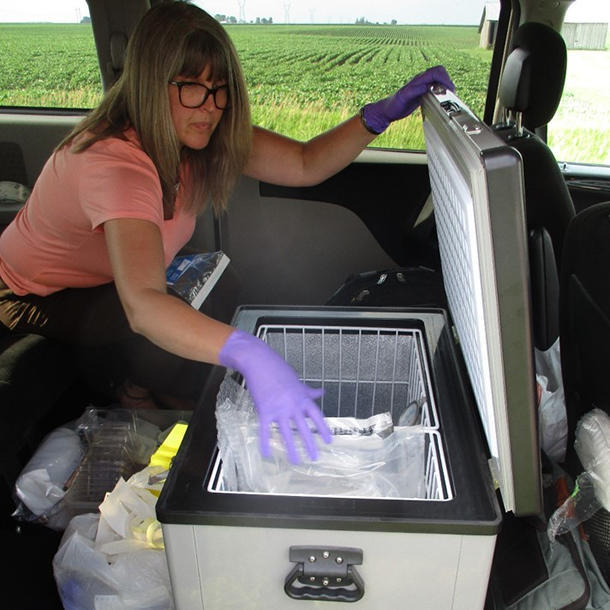Exposure-Response Observed for Urine Glyphosate Concentrations, Markers of Oxidative Stress
, by Jennifer K. Loukissas, M.P.P.
Glyphosate is the most widely used herbicide worldwide, and it has been classified by the International Agency for Research on Cancer (IARC) as a probable human carcinogen based in part on evidence of carcinogenicity in laboratory studies. In a molecular epidemiologic study that included glyphosate-exposed farmers as well as non-farmers, Jonathan Hofmann, Ph.D., M.P.H., senior investigator, and Vicky Chang, Ph.D. M.P.H., postdoctoral fellow, both in the Occupational and Environmental Epidemiology Branch, and colleagues, reported exposure-response relationships between urine glyphosate concentrations and increasing levels of two established urinary biomarkers of oxidative stress. The findings were published in the April 2023 issue of the Journal of the National Cancer Institute.
This study took advantage of urine samples and self-reported pesticide exposure histories that were collected from 268 male farmers and 100 matched male non-farmers in the Biomarkers of Exposure and Effect in Agriculture study, a subcohort within the Agricultural Health Study. After adjusting for urinary dilution and factors that may influence oxidative stress, the authors found that higher urinary glyphosate concentrations were associated with increased levels of 8-hydroxy-2′-deoxyguanosine and malondialdehyde, biomarkers of oxidative damage to DNA and lipid membranes, respectively. A similar pattern was observed among farmers who reported very recent use of glyphosate (within 1 day prior to sample collection). Furthermore, compared with non-farmers, they observed elevated levels of 8-iso-prostaglandin-F2α, a longer-term marker of oxidative damage to lipids, among farmers who reported recent glyphosate use (in the last 7 days) or high use in the last 12 months.
Very few studies in humans have investigated associations between glyphosate exposure and intermediate biomarkers related to cancer development, including oxidative stress markers. Most that did so had small sample sizes, relied on a single exposure assessment method, and lacked detailed information on the timing, frequency, or history of glyphosate use. The findings contribute to the weight of evidence supporting an association between glyphosate exposure and oxidative stress, a key characteristic of carcinogens, and provide mechanistic insights and biological plausibility for the potential role of glyphosate in the development of certain hematologic malignancies.
The authors emphasized the need for future research to incorporate additional biomarkers of oxidative stress and/or other intermediate endpoints related to cancer development, including use of untargeted approaches such as metabolomic profiling, to better explore biological mechanisms underlying the potential associations between glyphosate exposure and cancer risk. Importantly, evidence from mechanistic studies, especially in exposed human populations, could help inform future evaluations of the carcinogenic potential of this widely used herbicide.
Reference
Chang VC. et al. Glyphosate exposure and urinary oxidative stress biomarkers in the Agricultural Health Study. J Natl Cancer Inst. 2023
